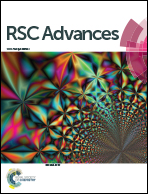Development of novel hydrogels based on Salecan and poly(N-isopropylacrylamide-co-methacrylic acid) for controlled doxorubicin release†
Abstract
Salecan is a novel water-soluble extracellular polysaccharide composed of a linear repeating unit of 1-3-linked glucopyranosyl. Salecan is suitable for the preparation of hydrogels for biomedical applications due to its outstanding biological and physicochemical profiles. Here we designed a novel semi-interpenetrating polymer network (semi-IPN) hydrogel that incorporated the hydrophilic polysaccharide Salecan into a stimuli-responsive poly(N-isopropylacrylamide-co-methacrylic acid) (PNM) hydrogel matrix for controlled drug release. In this research, on one hand, Salecan modified the architecture and the pore size of the semi-IPN network. On the other hand, Salecan played a vital role in modulating water content and tuning the water release rate of the developing hydrogel, resulting in an adjustable release rate of the drugs. Doxorubicin (DOX), an anticancer drug, was loaded into the semi-IPN hydrogels as a model drug, and the in vitro release assay exhibited that the release rate was closely related to the content of introduced Salecan, as well as the environmental temperature and pH of the release media. Cytotoxicity experiments demonstrated that all blank semi-IPN hydrogels were non-toxic to HepG2 and A549 cells, while drug released from the DOX-loaded hydrogels could still exert its pharmacological activity and had the ability to kill these two cancer cells. Altogether, this work provides a way to synthesize a new type of hydrogel as general drug delivery vectors with a desired release rate.


 Please wait while we load your content...
Please wait while we load your content...